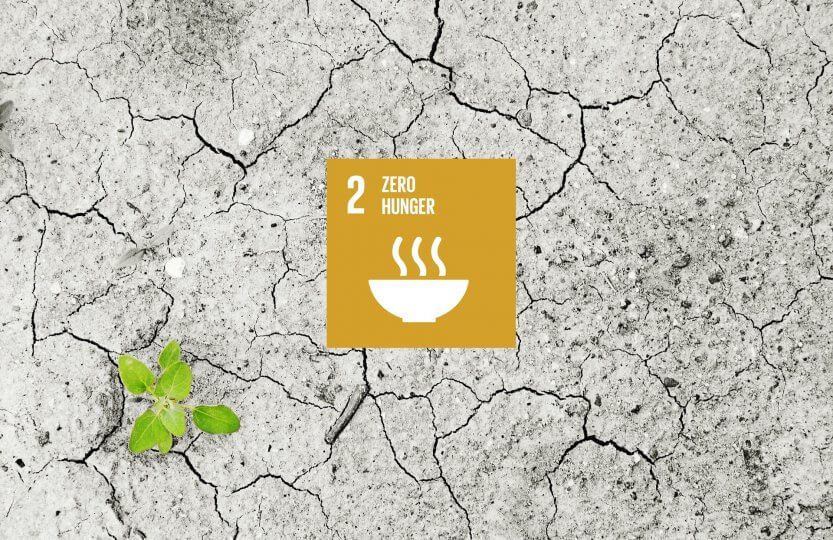There are 7,865,834,495 [1] people (and counting!) currently alive on our planet. Out of that count, around 9 million people die of hunger each year [3]. It is clear that at the same time as humanity faces other struggles, like the COVID-19 pandemic or climate change, hunger remains a major threat and concern for us all. The battle against hunger is a fight for everyone, and that is where the heart of the second sustainable development goal lies: zero hunger.
The SDG 2 consists of ending hunger, achieving food security and improved nutrition, and promoting sustainable agriculture. However, it should be noted that the SDGs impact each other – they are intertwined. For example, by eradicating poverty (SDG 1), people will have a better income to acquire food to nourish themselves (SDG 2); by ending hunger (SDG 2), health, well-being, and quality of life will be ensured (SGD 3); and by implementing more sustainable agricultural practices (SDG 2), food production and security can be accomplished while taking action against climate change (SDG 13). Therefore, when one is improved, progress is also made in others.
Affected by poverty, climate change, man-made conflicts, locust crisis, and now the COVID-19 pandemic, the hunger issue continues to worsen and is unlikely to meet the 2030 SDG deadline. However, progress to reach the SDG 2 was already slow before the pandemic, as the population that suffered from moderate or severe food insecurity rose from 23.2% in 2014 to 26.2% in 2018 [4]. In this context, 60% of people who suffer from hunger are women [5], due to gender inequalities (SDG 5), which, consequently, affect their children’s physical and mental development. In 2019, it is accounted that 21.3% of children under 5 years old are stunted, and 6.9% are affected by wasting [2], while a child dies every 10 seconds due to undernourishment [3].
At the same time, estimates show that enough food is produced to feed everyone in the planet [8]. Why then do we have this problem? While poverty limits people’s ability to buy their own food, a primary problem lies in food waste. Every year, 1/3 of the world’s food is lost or wasted [9] – to put this in perspective, this number equates to 1.3 billion tons of food that could be consumed [3]. In Latin America, the amount of food that is wasted or lost could feed 300 million people; the food wasted in Europe could feed a total of 200 million people; while in Africa, the food that is lost could feed 300 million people [10]. This lost or wasted food could feed the 800 million people that suffer from hunger and undernourishment [3].
In order to meet the food security goal, four dimensions – defined by the FAO at the World Food Summit in 1996 – should be fulfilled. These include: availability, access, utilization, and stability [7]. Availability relates to the food production and supply, stock levels, and net trade. Access incorporates the economic and social side regarding policies focused on incomes, markets, and prices. Utilization refers to the adequate nutritional and energetic intake necessary for the well-being and health of the individuals. Stability concerns the maintenance of the other three dimensions over time, on a periodic basis, enabling good nutritional status [7].
Around 9% of the world’s population suffer from hunger [6]. It could be considered the world’s biggest health problem, as millions die from hunger and undernourishment every year – in greater numbers than from malaria, tuberculosis and HIV combined [11]. Much has to be done: Restructuring food systems, improving productivity while decreasing losses and waste, ensuring accessibility, promoting social protection programmes, giving immediate aid to vulnerable populations, and supporting smallholder farmers’ ability to increase food production with more sustainable agricultural practices. On the individual level, we can limit our food waste (THINK-EAT-SAVE), donate to people in need, support local producers, and have a vision of solidarity and cooperativeness.
In light of the SDG 2, the United Nations World Food Programme developed the project Share the Meal which functions as a crowdfunding where you can donate $0.80 directly from your phone by using their app [12]. This project was launched in 2015, and the donations were able to help people that suffer from food crisis in different places of the world. Watch the video below to understand how it works and how you can help.
References:
[1] The World Counts – World Population
[3] The World Counts – People and Poverty
[4] SDG 2
[5] Mercy Corps
[6] FAO The State of Food Security and Nutrition in the World
[7] An Introduction to the Basic Concepts of Food Security
[8] World Hunger
[9] FAO – Food Loss and Food Waste










This a very informative and educative article. Thanks Everton